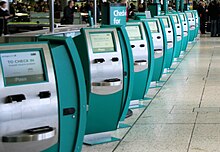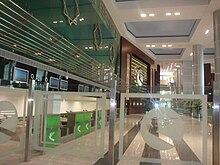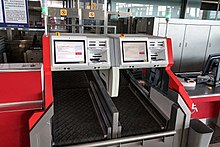




Airport check-in is the process whereby an airline approves airplane passengers to board an airplane for a flight. Airlines typically use service counters found at airports for this process, and the check-in is normally handled by an airline itself or a handling agent working on behalf of an airline. Passengers usually hand over any baggage that they do not wish or are not allowed to carry in the aircraft's cabin and receive a boarding pass before they can proceed to board their aircraft.
Check-in is usually the first procedure for a passenger when arriving at an airport, as airline regulations require passengers to check in by certain times prior to the departure of a flight. This duration spans from 15 minutes to 2 hours depending on the destination and airline (with self check in, this can be expanded to 30 days, if checking in by online processes). During this process, the passenger often has the ability to ask for special accommodations such as seating preferences, inquire about flight or destination information, accumulate frequent flyer program miles, or pay for upgrades. The airline check-in's main function, however, is to accept luggage that is to go in the aircraft's cargo hold and issue boarding passes. The required time is sometimes written in the reservation, sometimes written somewhere in websites, and sometimes only referred as "passengers should allow sufficient time for check-in".
In-town check-in service is a service offered by some cities such as Abu Dhabi, Seoul, Hong Kong, Delhi, Kuala Lumpur–International, London, Stockholm, Vienna and Taipei, where passengers may check in luggage in designated places within the city but outside the airport. This reduces check-in time and queuing at the airport.
Types of check-in
Destination or Point Check-in
If passenger is checked in for only one sector of the flight, then it is called destination or point check-in.
Through Check-in
If a passenger is checked on all the onward flights and has boarding passes for all the connecting flights and bags are also through checked to the final destination i.e. passenger does not need to recheck themself and the baggage again on the transit, then the check-in is known as through check-in. A passenger can avail through check-in facility mostly when the travel is completely with one single airline.
Passenger identity registration
Further information: Border control § Informal prescreeningAt the time of check-in, one of the agent's primary duties is to check for valid documents. This includes tickets, passports, visas, letters of consent, and in some cases, passengers' address and contact details to comply with immigration requirements.
Some airlines may ask passengers to present the original credit card used for payment.
Baggage registration
At the time of check-in, the passenger hands over baggage which is checked by the airport security and may be sealed (subject to the security regulations in that country). Anything that is above the weight limit or which is not allowed to be carried by the passenger themselves in the aircraft cabin is usually handed over to the agent at the time of check-in. The baggage allowance, if any, is prescribed by the airline and anything in excess may be refused or warrant additional surcharges, at the airline’s discretion.
Self-service bag drop

Some airlines have a self-check-in process allowing passengers with bags to check-in at Self Bag Drop machines. Passengers then attach the baggage tag and drop the bag at the baggage drop belt. Passengers without checked luggage can go straight to the lounge (if entitled to lounge access) and check in at the kiosk there using their ePass (a small RFID device only for its premium customers) or proceed straight to the departure gate. Many airlines use electronic check-in such as ePass, mPass, or similar mobile apps, and these applications serve as the boarding pass.
Electronic bag tags
More and more airlines are also allowing the use of electronic bag tags, which replace the traditional paper tags with a digital version that can be updated via a smartphone app. Electronic bag tags are designed to streamline the baggage check-in process, allowing passengers to pre-tag their luggage from anywhere before arriving at the airport. Once at the airport, passengers simply drop off their luggage at a designated self-service drop point or at a traditional check-in counter if preferred. This innovation reduces check-in time and also reduces the chance of lost luggage, as electronic tags are more durable and less likely to be misplaced or damaged during handling. Passengers can use their electronic bag tags from BAGTAG with Lufthansa, Qatar Airways, Alaska Airlines, KLM, SWISS, Austrian Airlines, Air Dolomiti, Discover Airlines, Icelandair, Aegean, Horizon Air, Skywest and China Southern.
Seating assignment
Usually at the time of check-in, an option of selecting a specific seat is offered, with passengers asked if they prefer a window or an aisle seat.
Online check-in
Online check-in is the process in which passengers confirm their presence on a flight via the Internet and typically print their own boarding passes. Depending on the carrier and the specific flight, passengers may also enter details such as meal options and baggage quantities and select their preferred seating.
This service is generally promoted by the airlines to passengers as being easier and faster because it reduces the time a passenger would normally spend at an airport check-in counter. Some airlines, however, would still require passengers to proceed to a check-in counter at the airport, regardless of preferred check-in method, for document verification (e.g., to travel to countries where a visa is required, or to ensure the credit card used to purchase is genuine and/or matches the identity of the person who made the purchase). If passengers need to continue the check-in process at the airport after performing an online check-in, a special lane is typically offered to them to reduce wait times unless all desks are designated as baggage drop-off points. Furthermore, online check-in for a flight is often available earlier than its in-person counterpart. The process then transfers to passengers' control over their check-in. Airlines may use the system because self-service is frequently more efficient to operate, with a greater ability to cope with surges in passenger numbers. It also lessens activity at the airport, saving airlines money and reducing passenger waiting times.
Ryanair charges passengers a fee which can amount to 60 Euros for not using online check-in, except in certain limited circumstances. Furthermore, by the start of 2010, all passengers were required to check in online, therefore abolishing the use of check-in desks. Despite this, passengers are still charged to print their boarding cards out.
Online check-in is increasingly becoming required in other legacy carriers, particularly in Europe as the airport check-in desks are being relegated as baggage drop points only.
Alaska Airlines was the first to offer online check-in. The system was first offered on a limited basis starting in the second quarter of 1999, and was available to the general public on selected flights the following quarter. Since then, a growing number of airlines have introduced the system.
British Airways were the first airline to deploy online check-in globally having sealed approval from both the CAA (Civil Aviation Authority and FAA (Federal Aviation Authority) for use of the 3-D Barcode technology.
Typically, web-based check-in for airline travel is offered on the airline's website not earlier than 24 hours before a flight's scheduled departure or seven days for Internet Check-In Assistant. However, some airlines allow a longer time, such as easyJet, which opens it 30 days beforehand. Depending on the airline, there can be benefits of better seating or upgrades to first class or business class offered to the first people to check in for a flight. In order to meet this demand, some sites have offered travelers the ability to request an airline check-in prior to the 24-hour window and receive airline boarding passes by email when available from the airline. Some airlines charge for the privilege of early check-in before the 24-hour window opens, thus capitalising on the demand for desirable seats such as those immediately behind a bulkhead or emergency exit row, such as Ryanair, which allow check-in up to 60 days before the flight for passengers who pay for a seat reservation.
Mobile check-in
In the mid-late 2000s, checking in was made possible using a passenger's mobile phone or PDA. A GPRS or 4G-capable smartphone or an internet-capable PDA is required in most instances (Finnair allows check-in by text message), and the check-in feature may be accessed by keying in a website on the mobile phone's browser or by downloading a dedicated application. The process is then similar to that which one would expect when checking in using a personal computer.
At the end of the mobile check-in process, some airlines send a mobile boarding pass to a passenger's mobile device, which can be scanned at the airport during security checks and boarding. However, others send an electronic confirmation with a barcode that can be presented to the staff at check-in or scanned at the kiosks to continue the check-in process (i.e., to have boarding passes issued).
One disadvantage of early check-in is that it puts a restriction on a person's agent changing their flight. As the ticket coupon has to be reset back to OPEN again prior to any changes being made, this may take some time to arrange.
Premium check-in and lounge access
If the passenger carries a first or business class ticket or presents a certain frequent flyer program membership card (usually the higher-level tiers), or any other arrangements with the carrier, access to the premium check-in area and/or the lounge may be offered.
Premium check-in areas vary among airlines and airports. The main airport in which an airline hub is located normally offers a more thorough and exclusive premium check-in experience, normally inside a separate check-in lounge. For example, Air New Zealand's Auckland International premium check-in lounge provides a dedicated customs clearance counter and direct shortcut access to the security checkpoints. Airlines operating in minor airports generally offer an exclusive and separate premium check-in queue lane, often combined for its first, business, and/or premium economy passengers.
Singapore Airlines also offers this service to First Class and Suites passengers, whose flights depart Singapore Changi Airport's Terminal 3. These passengers have a dedicated curb side entrance and can wait at couches while staff assist them in checking-in. They are then led to a dedicated passport control counter.
Emirates provides its first-class/business-class customers with individual and separate check-in lane at its hub DXB, to divide most economy-class customers from main check-in lobby apart, and then ensuring those first-class/business-class customers' privacy.
SkyTeam provides the priority check-in service "SkyPriority", whose members could access the check-in counter to authorize the prioritized check-in service, along with the larger luggage capacity.
In-town check-in
In some cities (including Dubai, Sharjah, Hong Kong, Kuala Lumpur, New Delhi, Chennai, Seoul, Vienna and Taipei), certain airlines provide in-town check-in services, allowing passengers to check their luggage at check-in counters located in railway or subway terminals as much as a day ahead of time. This service allows passengers to take a train to the airport without the burden of carrying their luggage to the airport terminal;
- In Seoul, for example, Korean Air, Asiana Airlines, Jeju Air, T'way Air, Air Seoul, Air Busan, Jin Air, Eastar Jet and Lufthansa offer in-town check-in services at Seoul Station City Airport Terminal.
- In Kuala Lumpur, Malaysia Airlines and Cathay Pacific offer in-town check-in at KL Sentral.
- In Taipei, China Airlines, EVA Air and Starlux Airlines offer in-town check-in at Taipei Main Station.
Also, elected airports in London, Geneva and Zurich, people make use of baggage collection service such as Airport where bags are collected from home.
References
- "Online Check-in". www.easyjet.com. Archived from the original on 2023-05-12.
- "Air New Zealand ePass". Air New Zealand. 2009. Archived from the original on 2009-02-19. Retrieved 2009-08-24.
- "Air New Zealand mPass". Air New Zealand. 2009. Archived from the original on 2009-04-11. Retrieved 2009-08-24.
- Virgin launches online check-in, Sydney Morning Herald, 3 October 2005
- "Ryanair to abolish check-in desks". BBC Online. 21 Feb 2009.
- "First passenger checks in, receives boarding pass via the internet", Business Wire, 16 September 1999
- "Mobile boarding passes is five years old". British Airways | Media Centre. July 16, 2015. Archived from the original on May 17, 2023.
- Warf, Barney (2018-05-15). The SAGE Encyclopedia of the Internet. SAGE Publications. ISBN 978-1-4739-6035-0.
- "Important Check-in Information". help.ryanair.com. Archived from the original on 2023-02-15.
- "Finnair to introduce the world's easiest checkin -- with a text message". Finnair Group. Archived from the original on 2015-05-29. Retrieved Sep 28, 2004.
- "Emirates". Retrieved 11 August 2015.
- "Privileges and Complimentary Services: Free In-town Check-in Service". mtr.com. Retrieved 5 February 2014.
- "City Airport Terminal > Use Information > Available Airlines". AREX. Retrieved 2024-05-07.
- "Malaysia Airlines Extends KL City Air Terminal Check-In Services To Cathay Pacific". Asia Travel Tips. Retrieved February 6, 2014.
- "Taoyuan Airport MRT A1 Taipei Main Station In-Town Check-In Services". Taoyuan Airport Company. Retrieved January 22, 2019.
- "Airportr service". Airportr. Retrieved 2022-11-14.